Skin sores can develop due to pressure, friction, moisture, burns or even accidents. They often happen without a person knowing it because of absent sensation to the area. Sores can easily become infected and may channel into deeper levels of muscle and bone. Healing can be difficult and may lead to future problems that require surgery and long hospital stays. Please read on for more information on the different causes and signs of skin problems.
Causes of Skin Problems
Pressure is the biggest cause of skin breakdown and sores because it decreases blood flow to the skin. It is most likely to occur over bony areas where there is not much padding between the skin and the bones.
Examples of pressure include:
- Sitting or lying in one position for long periods
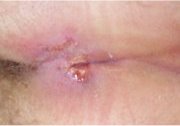
- Wearing clothes or shoes that are too tight
- Using a wheelchair that is the wrong size
- Wearing casts or splints that are too tight
- Not using a properly adjusted wheelchair cushion
- Sitting on unpadded surfaces
Pressure problems can be prevented by:
- Doing weight shifts correctly and on time

- Wearing properly fitting clothes and shoes
- Using properly fitted wheelchair and cushion
- Inspecting wheelchair regularly for wear and tear
- Checking skin under splints regularly and removing them if red spots are noticed
- Calling the doctor promptly when skin breaks down
Shearing happens when something stretches or pulls on the skin. This also leads to decreased blood flow to the skin and deeper tissues under the skin.
Shearing can occur as a result of:
- Slumping in the wheelchair
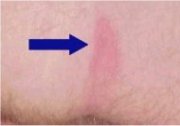
- Sliding the body over a surface such as when doing a transfer or raising up in bed
- Sitting in bed too long
Friction is another way the skin can be injured. It occurs when the skin is rubbed hard across another surface. Friction can actually result in an open area on the skin.
Examples of friction include:
 Any movement that causes a body part to rub across another surface
Any movement that causes a body part to rub across another surface- Performing a sliding board transfer incorrectly and rubbing the buttocks over the wheelchair tire
Accidents can also happen. They include bumps, bruises, cuts or burns th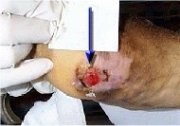 at injure the skin. Remember that feeling may be decreased or absent so a person may not even know that an injury occurred during an accident.
at injure the skin. Remember that feeling may be decreased or absent so a person may not even know that an injury occurred during an accident.
Examples of accidents include:
- Bumping feet in doorways when moving about in a wheelchair
- Coming in contact with things that are hot (surfaces, boiling water, reaching over a hot burner)
- Bumping any body part
- Spilling hot drinks
Accidents can be prevented. Consider the following:
- Be careful when driving your chair so as not to bump any body parts.
- Use a lapboard attached to your chair when cooking or carrying hot things.
- Cook on the front burners so you do not have to reach over hot surfaces (if possible).
- Use a cup holder attached to your wheelchair for hot liquids.
Moisture is wetness on the skin. It can soften the skin too much and make it more likely to break down and become a sore.
Examples of moisture include:
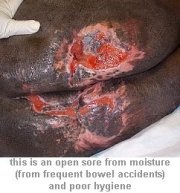 Urine that stays on the skin from wetting accidents, leaking condom catheter or poor hygiene
Urine that stays on the skin from wetting accidents, leaking condom catheter or poor hygiene- Stool that stays on the skin from bowel accidents or poor hygiene
- Sweat from overheating or infections with fever
- Water
Moisture problems can be avoided. Try the following to prevent skin breakdown from moisture:
- Perform bladder program on time and empty completely each time. Avoid bladder accidents.
- (Men) wear a condom catheter in case of reflex in between bladder programs.
- Perform bowel program on time, each time and for the proper amount of time.
- Avoid bowel accidents.
- Clean the skin right away if bowel or bladder accidents happen.
- Dry off sweat that results from activity or fever.
- Change bathing suit after swimming to avoid sitting in wetness for long periods.
- Use petroleum jelly on buttocks area if diarrhea is a problem.
- Stay dry!
Swelling of the limbs (usually the feet or hands) can result from absent or limited movement. Extra body fluids collect in the limbs and make the skin very fragile
Ways to decrease swelling include:
- Avoid pressure on legs and hands.
- Elevate legs and hands several times a day (prop on pillows/foam pads while in bed).
- Wear support stockings (TED hose or JOBST stockings).
- Keep shoes loose.
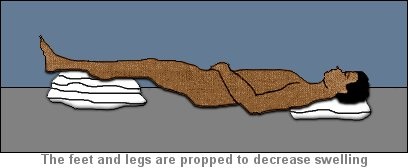
Other problems of the skin can be caused by poor nutrition, smoking, dry and flaky skin, poor hygiene when cleaning after bowel or bladder programs and worn out wheelchair cushions.
Signs of skin problems include:
- reddened or darkened areas
- swelling
- any change in the color of the skin
- raised or hardened areas
- bruises
- warm areas felt near a red, dark, raised or hardened area
- blisters
- rashes
- any opening on the skin
Skin is more likely to exhibit problems over bony areas. Pressure points will vary depending on whether the person is sitting or lying on the back, side or stomach. Please review the following pictures of positions and potential skin breakdown areas.
Pressure areas likely to happen while on the back:
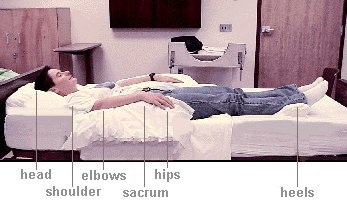
Pressure areas likely to happen while sitting:

Pressure areas likely to happen while on the side:
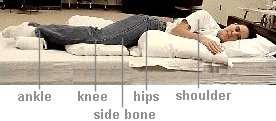
Pressure areas likely to happen while on the stomach:

It is important to check the skin at least twice a day. Skin checks are quick and easy to do and will save the skin from unwanted skin sores. Prevention is the key!


